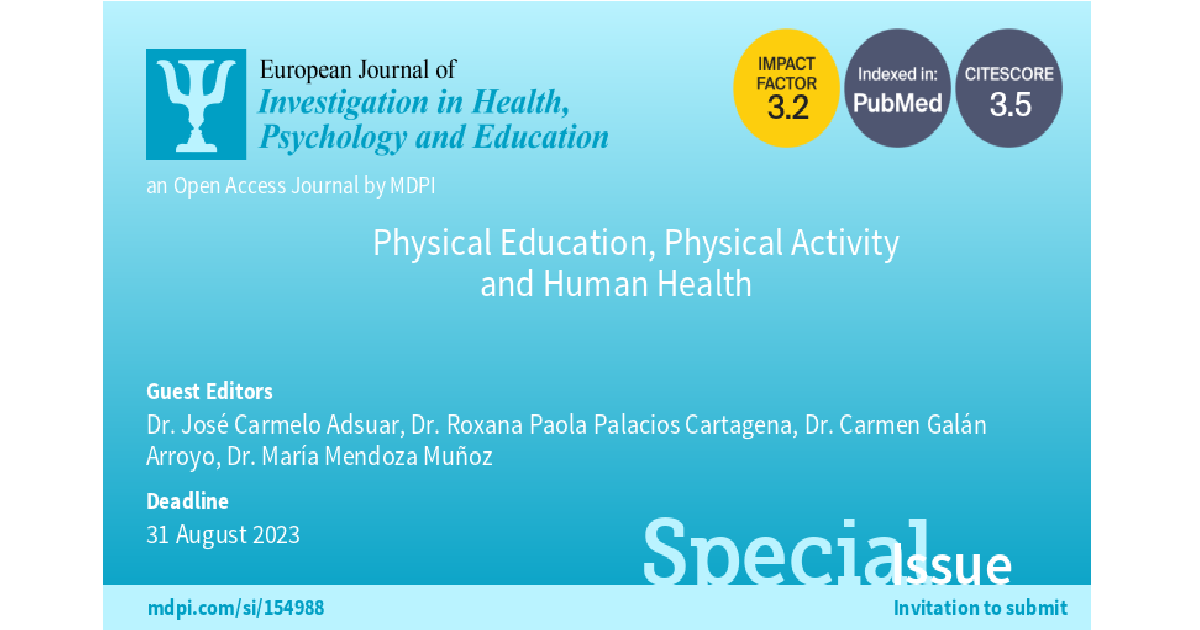Physical Education, Physical Activity and Human Health
A special issue of European Journal of Investigation in Health, Psychology and Education (ISSN 2254-9625).
Deadline for manuscript submissions: closed (31 August 2023) | Viewed by 24365

Special Issue Editors
Interests: global health; physical and sports activities as a strategy to promote a healthy society; physical activity interventions; exercise training physical exercise; physical health; assessment of physical capacity; health, quality of life in groups of subjects and active lifestyle (elderly; children, type 2 diabetes, Parkinson, etc.); balance and muscle strength; rehabilitation; osteoporosis; fall prevention; validity and reliability of physical fitness testing; active tourism; outdoor behavioral healthcare; wilderness therapy; forest bathing; shinrin-yoku; Buddhist walking
Special Issues, Collections and Topics in MDPI journals
Interests: sport science; global health; physical education; physical activity; physical fitness; physical performance; physical exercise training; physical capacity assessment; health, quality of life and active lifestyle (children, adolescents, adults)
Special Issues, Collections and Topics in MDPI journals
Interests: education sciences; physical education; special educational needs; educational psychology; global health; physical health; physical activity interventions; physical exercise training; assessment of physical capacity; health, quality of life and active lifestyle; balance and muscle strength; fall prevention; validity and reliability of physical fitness testing; active ageing; adherence to physical activity; outdoor behavioral healthcare; active tourism; physical activities in nature
Special Issues, Collections and Topics in MDPI journals
2. Departamento de Desporto e Saúde, Escola de Saúde e Desenvolvimento Humano, Universidade de Évora, 16 7004-516 Évora, Portugal
Interests: fitness; sport; adolescent; children; physical condition; obesity; health; well-being; physical literacy
Special Issues, Collections and Topics in MDPI journals
Special Issue Information
Dear Colleagues,
The importance of physical education and physical activity is unquestionable. They positively influence the functioning of the body, providing multiple benefits at therapeutic and preventive levels. It is therefore important to promote healthy lifestyles for optimal human health.
Following the success of the previous edition, this Special Issue aims to disseminate national and/or international research studies on the topics of physical education, physical activity and human health. We aim to highlight the relevance of these studies in addressing various issues and contribute to a better understanding of these topics.
We welcome submissions on the above topics in the form of: reliability studies, validity studies, correlational studies, observational studies, study protocols, longitudinal studies, cross-sectional studies, case reports, qualitative studies, studies with discourse analysis, bibliometric reviews, narrative reviews, scoping reviews, systematic reviews and meta-analyses.
Topics of interest include:
- Physical education;
- Physical activity;
- Human health;
- Exercise or sport and health;
- Welfare;
- Healthy habits;
- Gender and sport;
- The political economy of sport;
- Sport;
- Corporal expression;
- Inclusive and adapted sport;
- Physical literacy;
- Fitness tests.
Dr. José Carmelo Adsuar
Dr. Roxana Paola Palacios Cartagena
Dr. Carmen Galán Arroyo
Dr. María Mendoza Muñoz
Guest Editors
Manuscript Submission Information
Manuscripts should be submitted online at www.mdpi.com by registering and logging in to this website. Once you are registered, click here to go to the submission form. Manuscripts can be submitted until the deadline. All submissions that pass pre-check are peer-reviewed. Accepted papers will be published continuously in the journal (as soon as accepted) and will be listed together on the special issue website. Research articles, review articles as well as short communications are invited. For planned papers, a title and short abstract (about 100 words) can be sent to the Editorial Office for announcement on this website.
Submitted manuscripts should not have been published previously, nor be under consideration for publication elsewhere (except conference proceedings papers). All manuscripts are thoroughly refereed through a single-blind peer-review process. A guide for authors and other relevant information for submission of manuscripts is available on the Instructions for Authors page. European Journal of Investigation in Health, Psychology and Education is an international peer-reviewed open access monthly journal published by MDPI.
Please visit the Instructions for Authors page before submitting a manuscript. The Article Processing Charge (APC) for publication in this open access journal is 1400 CHF (Swiss Francs). Submitted papers should be well formatted and use good English. Authors may use MDPI's English editing service prior to publication or during author revisions.
Keywords
- health
- physical activity
- exercise
- culture
- sports performance
- sports training
- health promotion
- health
- inclusion
- health-related quality of life
- obesity









